|
FELINE STRUVITE BLADDER STONES

STRUVITE BLADDER STONES IN THE CAT
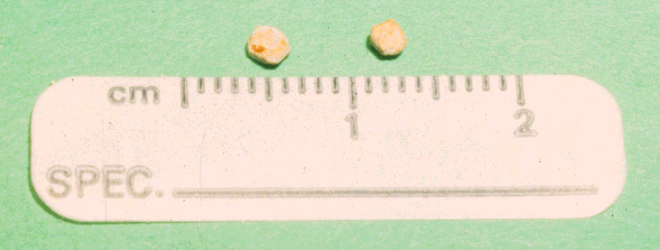
(Photocredit: Joe Bartges, DVM, PhD, DACVIM, DACVN, used with permission)
WHAT IS STRUVITE?
Struvite is a urinary mineral composed of ammonium, phosphate, and magnesium. These three substances are common in urine and if they exist in high enough concentrations, they will bind together in the form of crystals. Struvite crystals are found in urine normally and have no significance on their own. Problems occur when these crystals combine with mucus and form a urinary plug that can actually cause a blockage in a male cat’s urinary tract (see our page on Feline Urinary Blockage) or when the crystals bind together to form an actual bladder stone.
Struvite is also sometimes called “triple phosphate,” based on some early studies that had misidentified the minerals. The name has stuck, though, so you may hear this term.
In older times, feline bladder stones could virtually be counted on to be struvite, as opposed to some other type of mineral. Nowadays, because of widespread cat food reformulation in the 1980’s approximately 50% of feline bladder stones are struvite and the other 50% are calcium oxalate.
|
IF STRUVITE CRYSTALS ARE NORMAL, WHY DO SOME CATS FORM STONES?
There are several factors at play here. The pH of the urine, presence of proteins around which the crystals can aggregate, and urinary water content all are important issues. Ultimately, these factors come together to contribute to a urine that is “supersaturated” with struvite. In dogs, infection is necessary to create a struvite bladder stone but in 95% of cats with struvite stones no infection was involved (though sometimes the presence of the stone can lead to infection.)
|
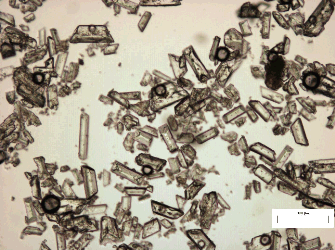
Struvite crystals under the microscope.
(Photocredit: Sustainable Sanitation Alliance via Wikimedia Commons)
|
SYMPTOMS
While bladder stones can sometimes be found incidentally while looking into another problem, most of the time they are found when the cat is showing signs of lower urinary tract disease:
- Straining to urinate
- Bloody urine
- Urinating in inappropriate locations
- Urinating small amounts frequently
These symptoms are expressed regardless of what the lower urinary tract disease is. Other lower urinary tract diseases include: idiopathic cystitis, bladder infection, bladder tumor, and more obscure issues such as healing bladder trauma. In cats showing signs of lower urinary tract disease, approximately 25% of them will have bladder stones so it is definitely worthwhile to take a radiograph of the bladder to check. A urinalysis will be helpful in determining the type of stone and in ruling out other causes of urinary symptoms.
|
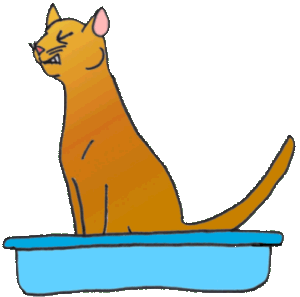
(original graphic by marvistavet.com)
|
|
TREATMENT: DIETARY DISSOLUTION
Struvite stones can be dissolved by feeding special diets. There are several commercial brands available and they all act by creating a bladder environment that is favorable to dissolving the struvite crystals back into the urine. In order to proceed with this form of treatment, the patient must eat the dissolution diet as his or her sole food. Obviously, the cat should not have a second disease which makes the stone diet inappropriate and the cat must be fed only the urinary diet and nothing else. If the cat does not like one diet, another can be selected; both dry and canned selections are available and can be mixed together though there is some thinking that the extra water that goes with a canned diet is more beneficial for stone dissolution.
A typical protocol involves radiographs every 3-4 weeks to confirm that the stone is actually dissolving though some cats are able to dissolve their stones in as short a period as seven days. If the stone does not completely dissolve, it may not be composed entirely of struvite (calcium oxalate stones will not dissolve with diet) or there may be some other reason why the stone is not dissolving (cat is sneaking food elsewhere etc.). On the average, it takes about 6 weeks for a stone to dissolve. If the stone does not seem to be dissolving after a reasonable time, the stone may require surgical removal.
|
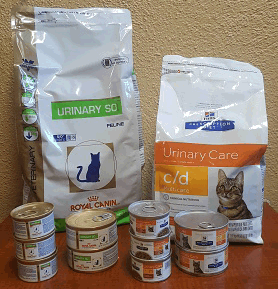 (original graphic by marvistavet.com) (original graphic by marvistavet.com) |
|
TREATMENT: SURGERY
Surgery to remove a bladder stone is called a “cystotomy.” Here, the bladder is opened and the stones inside are simply removed. The bladder and belly are closed up and the cat is able to go home when he or she has a good appetite and normal urination. Some blood in the urine can be expected for several days after surgery and there may be some urinary discomfort for the first several days necessitating pain medication.
After surgery, the stones are generally sent to a special laboratory for analysis to confirm the stone type.
|
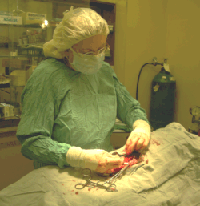
(original graphic by marvistavet.com)
|
OTHER METHODS OF STONE RETRIEVAL
|
Cystoscopy
A less invasive method involves using a cystoscope in one of two ways. A cystoscope is a long skinny instrument with a tiny video camera that can be inserted up the patient's urethra and into the bladder. Because cats are so small, this is only possible in female cats; the male cat's urethra is simply too small for a cystoscope.
Once inside the bladder, the scope employs a stone retrieval basket to capture small bladder stones and carry them out the urethra when the scope is withdrawn. If the stone is too large to pass through the urethra, it can be broken apart using laser lithotripsy. Here, a laser on the cystoscope is placed in contact with the stone and the stone is broken into pieces that are small enough to either pass or be carried out in the retrieval basket.
Obviously, special equipment is required in either of these situations and there is extra expense involved. That said, the recovery time is generally faster than with conventional surgery.
|
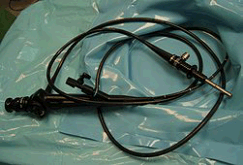
Cystoscope
(Photocredit: MykReeve via Wikimedia Commons)
|
Voiding Urohydropropulsion
This technique can work if the stones are small enough to pass through the patient's urethra. The patient is sedated, the bladder is distended with fluid, agitated, and manually expressed under pressure. By positioning the sedated patient vertically, gravity "loads" the stones in the neck of the bladder, positioned for expulsion. When the bladder is expressed, often stones can be passed that might otherwise have stayed in the bladder. Larger stones cannot be passed using this technique. Often voiding urohydropropulsion is used to collect sample stones for laboratory analysis prior to one of the other stone removal techniques since identifying the stone type is crucial to the selection of a stone removal technique.
PREVENTION
To avoid forming new struvite stones it is helpful to use a diet that creates a bladder environment that is not conducive to stone formation. There are numerous such urinary formulas and sometimes the same diet that was used to dissolve the stone can simply be continued. Ideally, a canned formula is used as canned foods have extra water and the extra water helps make for a more dilute urine (and a dilute urine means a lower crystal concentration).
If it is not possible to feed an appropriate diet, the use of urinary acidifiers may be necessary. Your veterinarian may recommend some monitoring tests to make sure the pH and urine concentration stay in a range where struvite stones should not form.

Page posted: 10/25/2011
Page last updated: 10/20/2021
Page last reviewed: 12/25/2023
|